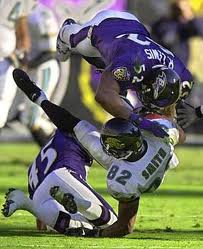Nope, not just another “Top 10” list. Soccer really needs help, so an eleventh recommendation is required.
The sport of soccer really needs a better publicist, president or commissioner. Because soccer is just not very popular.
Yes, in America, soccer remains one of the cheaper forms of group babysitting for kids. American soccer is nothing more than daycare with cardio and juice boxes. But it hardly qualifies as a sport.
Outside of the United States, apparently a zillion people watch the sport—or so we’re told by anyone who once called Europe, South America, or Africa home. Mind you, most of them don’t own television sets. Nor can any of them afford Fox Soccer Plus on DirecTV. Have you seen how poor most European nations are these days?
These Europeans, South Americans, and Africans claim soccer as the most popular sport primarily because they know the United States men will never be champions. It’s like Antonio Banderas rubbing it in Don Johnson’s face that he’ll never win Melanie Griffith back.
American style just doesn’t cut it outside of America.
Some of you wonder why I haven’t mentioned Asia as a soccer super power. Let’s see…China alone has over a billion people, and yet they can’t find anyone who can dribble a basketball with their hands—much less anyone who can dribble a soccer ball with their foot.
Soccer’s worldwide governing body, FIFA (Fédération Internationale de Football Association) is usually run by narrow-minded, politically-driven heads who sound more like characters from a STAR WARS movie. Names like João Havelange, Sepp Blatter, Jar Jar Binks.
I say all this, and yet I’m actually a fan of soccer. Well, not a big fan. But enough of a fan. Just like I’m a fan of hockey; I watch it only when it actually means something.
The World Cup and UEFA Euro tournaments are my soccer equivalent to the Stanley Cup or Olympics. (Be honest, you would never actually go to a sports bar to watch swimming, gymnastics, or track & field unless it was the Olympics. That makes you a fan of the Summer Olympics more so than a fan of any of those non-revenue sports.)
Make me FIFA President for one day, and I’ll make soccer more popular than the Olympics itself.
Here are 11 Ways To Make Soccer More Popular—even in America.
11. Goalies cannot be taller than 5 feet 6 inches. (For women, goalies cannot be taller than 5 feet). Jockey-size goalies! It’s no fun when goalies can just reach up on their tippie-toes to deflect shots above the crossbar. Plus, it gives your short, un-athletic kid a chance to actually feel like an athlete.
10. Create a three-point line. Shots from distance are worth three goals instead of just one. Three point shots can be more exciting than the penalty kick format.
9. Utilize instant replay together with Olympic figure skating-like judges to critique fake injuries. If the rest of the world made movies using current soccer players as actors, Hollywood movies would look more like America’s Favorite Bloopers compared to these new international films. In soccer, a player goes down with the lightest spring breeze. I’ve seen toddlers at the beach lose their balance less often than soccer players. Bump shoulders with a player, and he goes down clutching his knee in agony. But with the use of instant replay, a panel of judges can critique every injury and foul. Any player with the flair for over-dramatics gets sent to a penalty box.
8. Penalty boxes and power plays. Yes, enough of these meaningless whistles and fouls. If a player gets caught doing something wrong, then he should sit and play a man down. Guaranteed, it will reduce the number of flops and fake injuries.
7. Change the substitution rules. Currently, a team is allowed only three substitutions per game. Thus, players tend to pace themselves in order to last 90 minutes (or longer). Sometimes, a defender is standing within a couple yards of the ball, but he makes no aggressive move to steal the ball because he’s conserving his energy. Instead, soccer should adopt the substitution patterns of hockey and lacrosse—where players can sprint over to their benches so that fresh legs can sprint onto the field.
6. LeBron James. We need to find a way to put our best athletes on the soccer field. Imagine if the U.S. team can bring LeBron James off the bench for corner kicks and other set pieces. Imagine LeBron James soaring over the top of 6-foot defenders and heading the ball forcefully into the goal. Soccer doesn’t have salary cap rules like football or basketball. Nike can afford to pay LeBron $50 million to spend his 2014 offseason so that he can add depth to the U.S. bench at the World Cup in Brazil. It’ll be the best $50 million that Nike will have ever spent. Nike paid all their Asian factory children a lot less than $50 million over the past 20 years combined.
5. Designate one player per team in the special “enforcer” role. The enforcer is the only player on each team allowed to physically tackle or level another player with the ball. The enforcer is like Ray Lewis in the middle of the field. Smart teams should keep the ball away from the enforcer’s area. Smart players should keep their head on a swivel. Although no leaping off your feet and attacking with the crown of your head, or diving low to take out someone’s knees. Afterall, we have learned a couple valuable lessons from the NFL.
4. More Alex Morgan, U.S. National Soccer Forward!!!
Watch Alex in the Olympics this summer. You’ll be a fan.
You have no chance of scoring with Alex. But this prolific forward will score on anyone.
(When I was a “kid”, I had field seats to the U.S. women’s World Cup victory at the Rose Bowl; still the most electric live sports event that I’ve ever experienced—with or without Brandi Chastain removing her jersey.)
3. A shot-clock. Yes, soccer is a beautiful sport when a team controls possession of the ball. No, soccer is not a beautiful sport when half the passes go backwards to the goalie and sweeper. By instituting a new shot clock, shots on goal must be taken within 60 seconds after obtaining possession. Get the ball up the field! Shot clock resets whenever someone hits the crossbar, post, goalie, or any defender inside the goalie box with the ball. It will also help to speeden up throw-ins–even if the player has to run up into the stands to retrieve the ball while the shot clock continues to wind down.
2. All halves and overtime periods should start like dodgeball. Players must stand behind their end line, and when the whistle blows, they sprint for the ball sitting in the middle of the field.
Better yet, until the ball is cleared out of the midfield, teams should be able to fight just like the bloody battlefield scene in THE HUNGER GAMES. Do you choose your starting line-up based on speed? Or based on sheer savagery?
1. Penalty kicks should be won based on who can drill the goalie with a crotch shot—rather than who can avoid the goalie. The goal for penalty kicks should be who can strike the goalie in the balls–with the ball. Now that’s a display of pinpoint accuracy! Goalie must stand there with his hands behind his back. Give ’em a blindfold and a cigarette if they want. Opposing player then gets a “free kick” from the penalty kick spot. The object for these penalty kicks is–if you drill the goalie with a painful crotch kick–your team gets a point. However, if the same goalie can rise onto his feet within 30 seconds, then the point is negated, and the goalie’s team will actually earn the point.
(For women’s soccer, similar format, except it’s a boob shot instead of a crotch shot.)
Penalty kicks have never been so dramatic. Might not be the shot heard around the world, but it will certainly be the goalie save heard around the stadium!
Meanwhile, kids in poor countries can practice anywhere without access to a regulation field.
That’s the beauty of soccer. We just need to give soccer more of a chance.
(6/24/12)




















